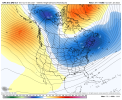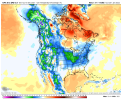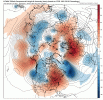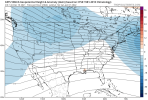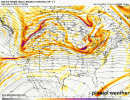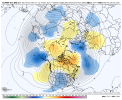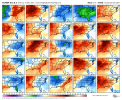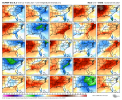My ideas have yet to change .. pattern change December 27- January 3 if we can score a little CAD action before hand I would be delighted
-
Hello, please take a minute to check out our awesome content, contributed by the wonderful members of our community. We hope you'll add your own thoughts and opinions by making a free account!
You are using an out of date browser. It may not display this or other websites correctly.
You should upgrade or use an alternative browser.
You should upgrade or use an alternative browser.
Pattern December to Remember
- Thread starter SD
- Start date
Blue_Ridge_Escarpment
Member
Well the CAD ice for Tuesday is back on the Canadian this run.
olhausen
Member
This. Give me 2 snows of 2-4 inches mixed in with multiple flurry and dustings in a season and Im a happy camper. I’m just grateful to live far enough north that regardless I get to see snow falling every year and usually get at least 2 inches of snow a season. 2016 / 2017 was the one year since 2006 that I didn’t even manage a dusting. I got 2-3 light flurries events and it was the worst winter ever.2-3 good snows and a good solid 10 days to 2 full weeks on winter weather will make most folks in my region happy. And that includes me.
L
Logan Is An Idiot 02
Guest
How was the GEFS?
The same as it has been to be honest. Had a little more 50/50 -nao signature vs 6z but was a little deeper with the wc trough at the same time. Later in the run it started hinting at the pac trough getting closer to the coast with the okhotsk low moving into the aleutians. Not much change tbh vs 6z though.How was the GEFS?
Looking at the 12z op, it was close to the mean with the larger players
Webberweather53
Meteorologist
Webberweather53
Meteorologist
Oh wow, a triple ridge bridge!


Getting awfully close to a GOA low and several other unfavorable things.
Webberweather53
Meteorologist
Getting awfully close to a GOA low and several other unfavorable things.
Looks fine to me.
So, arctic hounds about to be released?Oh wow, a triple ridge bridge!

Webberweather53
Meteorologist
So, arctic hounds about to be released?
That's how you get prolonged -AO/-NAO
Agreed, looks fine as is. But migrate the Greenland block any more poleward and the Aleutian ridge anymore westward, and you open the door for a big GOA low and the SE ridge to pop back up.Looks fine to me.
Avalanche
Member
Get in the zoneGefs finally washes out ridging all togetherView attachment 98172
Just a slight difference on the EuroAt least it would feel like Christmas



Webberweather53
Meteorologist
Agreed, looks fine as is. But migrate the Greenland block any more poleward and the Aleutian ridge anymore westward, and you open the door for a big GOA low and the SE ridge to pop back up.
I'm not reading that deep into a day 9-10 operational run. In general, what I see is fine and realistic overall. A ridge bridge is being tossed around on NWP and if one were to occur, predictability goes right down the toilet as would the stratospheric polar vortex. I don't see the -NAO disappearing for any extended length of time between now and at least mid-January or so
Me thinks if the Euro went to 384 like the gfs we would see the cold spilling out nationwide or at least some realignment in the pacific setting up a better pattern for us. But yeah at face value that would at least be a low amp SER heading into NYE but even then you'd have to question if the Euro is handling the pattern under the blocking properlyAgreed, looks fine as is. But migrate the Greenland block any more poleward and the Aleutian ridge anymore westward, and you open the door for a big GOA low and the SE ridge to pop back up.
Webberweather53
Meteorologist
Me thinks if the Euro went to 384 like the gfs we would see the cold spilling out nationwide or at least some realignment in the pacific setting up a better pattern for us. But yeah at face value that would at least be a low amp SER heading into NYE but even then you'd have to question if the Euro is handling the pattern under the blocking properly
The lead-up to that inside day 6-7 is more interesting to me because it's closer to verification but also we've been trending that way on the ensembles too. It's also consistent w/ the GWO evolution the last several weeks and where I think we're headed. I'd still be happy if the ECMWF panned out like that exactly because the long-term effects would be stronger/longer-lasting -NAO and -AO through the balance of January.
And with strong blocking taking shape over top that seems plausibleHonestly my first ? mark with the euro is hereView attachment 98173
How much interaction is there between the lobe over srn Canada and the energy crossing the US? More interaction likely ends up colder
Webberweather53
Meteorologist
3 blocking highs 1 north pole


Oh wow, a triple ridge bridge!

Maybe those runs dropping the entire PV on NA were not completely loopy.
Eps is trying to move the western trough east post 240. It's slow
If you could switch the high and low anomaly positions out west, oh boy ?3 blocking highs 1 north pole

iGRXY
Member
There's a lot of over the top blocking on the EPS and personally I think it is moving too slow with moving the tough east. The slow progression of the MJO maybe a reason for this. The -NAO is really nice as well which makes me think we would naturally have lower heights along the east coast.
There are a lot of very warm/cold members buried in the eps but the mean looks like it'll end up just on the warm side of normal through most of the run. It'll be interesting to see how this shakes out as we move forward in time and see more agreement
Weather channel just released the January through March forecast map it’s very hot Atlanta, GA and points south-west and also above normal Carolina’s up into Pennsylvania
Just a little volatility. So those individual members showing AN anomalies, are they showing less blocking over the top? Borderline wishcasting I know but I'd lean more on the cool side if the blocking is there
D
Deleted member 1449
Guest
You can have all the -NAO you want, but until that trough changes in the Pacific/P NW there's not much hope for us.


Not sure to be honest since wxbell doesn't individual h5 for the members. My assumption from just looking at how the temp anomalies move they are dumping in the west more than anything.Just a little volatility. So those individual members showing AN anomalies, are they showing less blocking over the top? Borderline wishcasting I know but I'd lean more on the cool side if the blocking is there
iGRXY
Member
That's not true at all lol.You can have all the -NAO you want, but until that trough changes in the Pacific/P NW there's not much hope for us.

Yep. That's what I was getting at earlier. I mean it's a 10 day map. So who knows.. And it IS better than the bright orange colors we were seeing over our area a few days ago. But you can't have the Greenland ridge rotate poleward and the EPO ridge retrograde westward. The response will inevitably be for heights to rise in the SE. That said, nothing is showing we have to go in that particular direction. Lots of possibilities exist. Maybe a rex block sets up out west. That would be good. There's plenty of cold to tap on our side of the globe. That's also really good.You can have all the -NAO you want, but until that trough changes in the Pacific/P NW there's not much hope for us.

SnowNiner
Member
You can have all the -NAO you want, but until that trough changes in the Pacific/P NW there's not much hope for us.

Patiently waiting for the GLAAD, -QBO, AAM, MJO, Jet Retraction, etc, or SOMETHING to take affect and kick that thing out of dodge! ???. So tired of seeing it. I'm sure when we do get an eastern trough, it'll be as transient as they come.
Today’s Euro Weeklies are warmer than Monday’s for the January portion averaged out in the E US though they’re not as warm as the run from one week ago. Of course, we won’t hear as much about this run from the mets on Twitter that were excited about Monday’s colder run.
You are correct. It has been shown on this thread countless times in the last week or more, along with past examples of why.That's not true at all lol.

